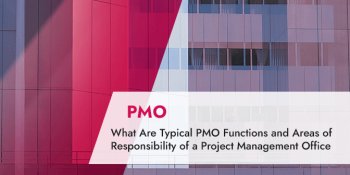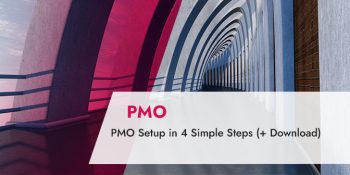If you are working on the PMO, you may also have to help manage the project portfolio. In this case, the preparation of project portfolio meetings should be one of your key tasks. As a rule, high-level employees will be among the participants. After the meeting, they should feel they have been thoroughly briefed and were able make informed decisions in all cases on the agenda.
In a nutshell: in your position as the PMO, you demonstrate to all participants in the project portfolio meeting that you are in full control of the project landscape.
Therefore, it is important to prepare this regular multi-project management meeting well, conduct it in a focused manner and keep it short. Thus, it will be perceived to be of particular value.
Definition Project Portfolio Meeting:
The project portfolio meeting is a meeting recurring at regular intervals addressing all projects in the multi-project landscape as a whole. The meeting enables participants to make important decisions furthering good management of the project landscape.
In this article, you will learn about the following topics:
- Challenges of the project portfolio meeting
- Who should participate in the meeting?
- What is the right cadence?
- What form should a successful agenda take?
- How do you prepare a project portfolio meeting properly?
- What are the criteria for projects that should be discussed in the meeting?
- Conclusion
Let us get started.
Challenges of the Project Portfolio Meeting
For the PMO, the challenges of the project portfolio meeting consist in the following:
- Inviting the right individuals who are authorized to make decisions; ideally, they will also be present every time
- Having to focus on the important projects, as this group of people generally has little time to spare
- Making this meeting a regular occurrence, as decisions are expected
- Ensuring the data presented is complete, up to date and plausible, i.e. prepared well by the PMO
Special Download: How to setup a PMO in 4 simple steps (PDF file)
Please fill in the form.
* Required Fields | Data Protection
What will come in handy with your PMO responsibilities is the TPG “PPM Paradise”.
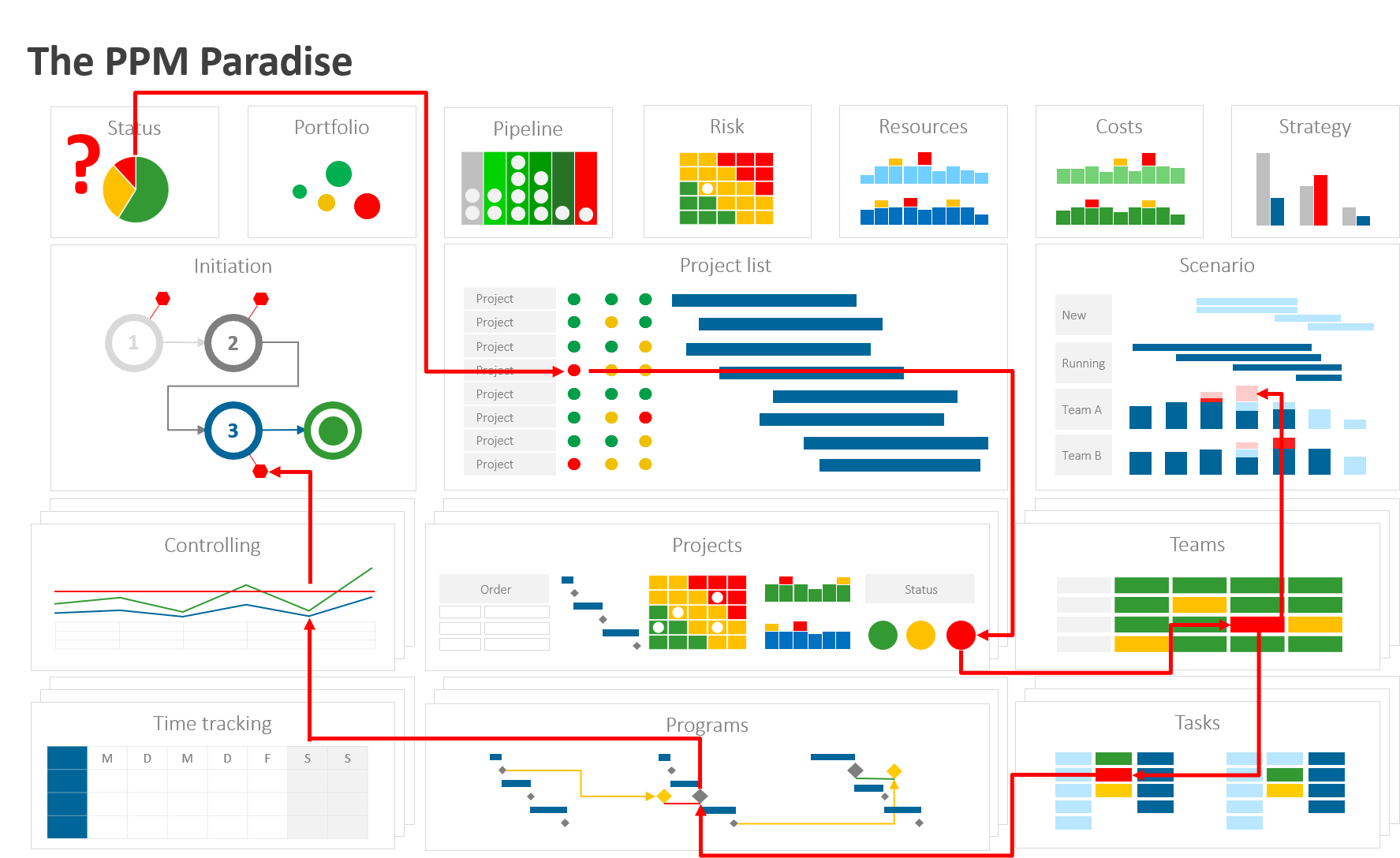
The top-level portfolio reports are fed from a project list stored in a central database. It is connected to a resource pool. Underneath, you find the methods for individual project management, which automatically fill the project list with information, such as for example the traffic light colors. The coordination of resources between project managers and team leaders is likewise part of this, as is the integration with accounting for forecasts, payment milestones and other questions of finance.
Filterable reports allow the user to get from the project list into the individual projects concerned, e.g. in the case of red traffic lights. This will give you an insight into the reasons for the comment (see red arrows in the graphic).
With such an integrated solution for multi-project and portfolio management, you can present the important information to people in the project portfolio meeting who have little time and inform them well.
Who Should Participate in the Portfolio Meeting?
Who exactly participates in the meetings depends on the objectives of the meeting and the requirements of the organization. And here is what you should bear in mind:
- Decision-makers need to be present or represented by somebody.
- Keep the list of regular participants the same. The PMO should be familiar with their expectations.
- As required, you can invite additional participants periodically to discuss particular subjects.
- The regular participants need to have time to make the meeting and be prepared.
- In many cases, inclusion in the meeting is also regarded as a status symbol in the company.
 Our tip:
Our tip:
Keep the group of participants rather small, no more than 5 to at most 10 people. If you invite people several times, it may become difficult to disinvite them later to return to the original size of the circle.
You should adjust the group of participants where necessary depending on the topics to be discussed. The smaller the company, the more likely it is that top management will be taking part as well. In larger companies, the heads of department are the more likely participants.
Participants for development projects could be as follows:
- PMO Manager
- Head of Development
- Head of Product Management
- Designated Team Leaders
- Representative of the Accounting Department
Participants for customer projects could be as follows:
- PMO Manager
- Head of the Customer Projects Department
- Head of Sales
- Designated Team Leaders
- Representative of the Accounting Department
Special Download (PDF): What are typical PMO Functions? (+ their importance)
This article provides you with a good comparison as well as ideas for functions you could consider next for your PMO. Please fill in the form to download.
* Required Fields | Data Protection
What Is the Right Cadence for Project Portfolio Meetings?
The project portfolio meeting has to occur on a regular cadence, which is specified by the PMO.

In most cases, the employees will report their actual hours at the end of the week. They will be the basis of the project managers’ weekly status meetings – which in turn provide the basis of the bi-weekly resource meetings between project managers and team leaders. This may be followed by the project portfolio meeting. Decisions that could not be made here need to follow in additional meetings directly after.
The rhythm is key! After all, this is the only way the team will get used to the regular procedure.
Not everything necessarily has to be decided at once. Questions of resource planning in particular can only be decided sensibly if there is a sound basis. This is only the case at certain points in the cadence at which all necessary information for the resource decisions is available and up to date.
Our tip:
If requests for resources come in out of sync with the cadence, point out that the cadence should be respected and refer to the upcoming project portfolio meeting. In the context of that meeting, the relevant decisions will be made in a way that is sensible from the perspective of the entire project portfolio.
One of the most important responsibilities of the PMO is to ensure reliability in the context of the project portfolio meeting. Yet, this will only work in sync with the cadence. Please pay attention to the following important points:
- The project portfolio meetings have to take place regularly, as project managers and other stakeholders are dependent on the decisions.
- The cadence is subject to the requirements of the organization. The question is what could happen between 2 meetings – and the PMO should set the cadence accordingly.
- Plan the dates in advance for the whole year. This is the only way to raise awareness among the decision-makers that this is an obligatory meeting.

A survey in our webinar on project portfolio meetings in October 2020 (German-language) revealed that almost 50% of almost 100 participants hold monthly project portfolio meetings. However, as mentioned above, the best cadence depends on the individual need at your company.
What Form Should a Successful Agenda of the Project Portfolio Meeting Take?
The most important, urgent and interesting has to go into the agenda of the project portfolio meeting. Roughly, this can include:
- Documentation of the participants and explanation of absences (obligatory meeting!)
- Status of project updates including the mention of project managers who have not updated their projects on time (as an educational measure) or the invitation of particularly successful project managers as an incentive for good performance
- Project completions with final report, successes and Lessons Learned
- Upcoming decisions in ongoing projects, depending on the type of projects – topics which the steering committee / project sponsor cannot decide
- Information on new projects: Project order with goals, deadlines, budget, project manager, resources
- Presentation of the resource situation with the resolution of resource overload and underload
- Publication of results with the selection of information, formulation and approval of the information for the staff

Our tip:
Make sure that at least the project managers, and possibly also the team leaders, will be informed about successes and important decisions from the meeting after every portfolio meeting (new projects, sales pipeline, great project statuses, hurdles overcome etc.). This will help prevent unchecked office grapevine.
The project portfolio meeting is where all decisions exceeding the competencies of the project managers, sponsors, steering committees and team leaders are made.
These could be:
- Announcement of project priorities
- Assignment of project managers
- Approval of projects or project stages as well as project budgets.
- Ending or stopping projects
- Postponing projects
- Authorization of changes in the scope
- Allocation of resources at project level
- Resolution of resource conflicts
- …
How Do You Prepare a Project Portfolio Meeting Properly?
To keep your meeting as concise as possible and be able to address the key topics precisely, the preparation provides an important permanent task for the PMO.
To fulfil this task, you require the regular reports of the project managers resulting from their project work. It is your role as the PMO to ensure data quality and check this with the project managers if necessary. On this basis, you prepare the meeting taking into account any newly added projects and strategic questions.
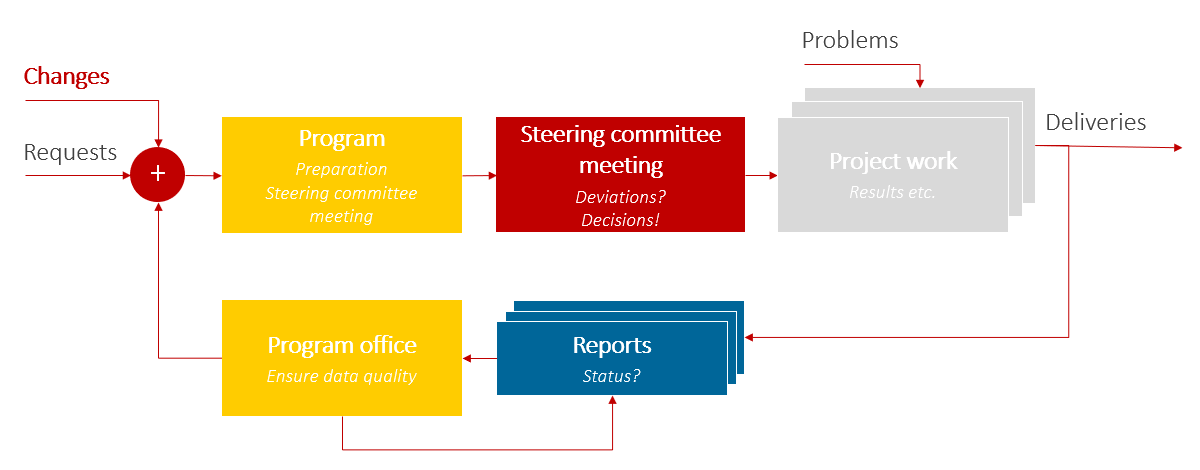
If the project managers’ information procurement takes too long, it is also the task of the PMO to improve the environment by providing assistance (e.g. coaching, better tools and methods).
As a rule of thumb, the status update for average projects should not take project managers longer than 2-3 hours per project.

Description of the above illustration: Assuming the project portfolio meeting is on a Wednesday, there should be a meeting with the team leaders directly before to clarify the current resource situation. You need to make sure that progress reporting and time tracking have taken place the Friday before. On Monday, there will be a reminder to employees who are running late. Thereupon, the project managers update and check their projects. On Tuesday, project managers who are running late receive a reminder to perform their updates.

Our tip:
In any case, set an early date for the editorial deadline for the preparation of the meeting. This will prevent last-minute changes that could destroy your preparation. Those who deliver later are to be classed as tardy employees.
In a webinar held in October 2020, the participants responded as shown in the illustration below regarding the duration of their project portfolio meeting: the majority (almost 50%) responded that it took “2 hours” and 25% responded “1 hour”.
Combined with the survey above, it would appear that the majority of companies conduct one two-hour project portfolio meeting per month.

Central Project List and Elements of the Project Reports
A current project list is indispensable for a good project portfolio meeting. It consists of information from the individual project status reports.
The information from the project status reports in the multi-project environment should be automatically entered into the project list. From the list, you can create multi-project reports at the push of a button and exchange data with the ERP system, e.g. via SAP integration.
All of this is possible with the “PPM Paradise” for instance, which we described above.
The figure below shows what important pieces of information you should summarize in a project list.
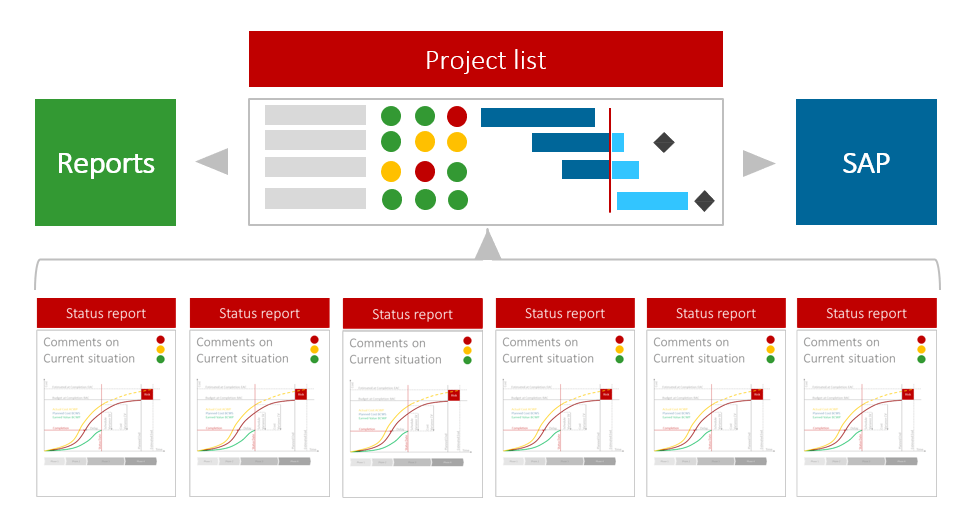
Please note: numbers are only one element of the report. A second part that is particularly important is the project manager’s comment. This enables the PMO and the participants of the project portfolio meeting to better understand the classifications for the traffic lights etc. After all, different individuals can set these in very different ways (for you will find a difference here between experienced and inexperienced project managers).
Moreover, the column with the date on which the project data was last published / saved is central to make sure the data presented from each project is truly up to date.

What should you pay attention to, if you want to make sure the project list is up to date? A few tips for you:
- Check if all projects have been saved and published in the last two days.
- Is there a project order for all new projects?
- Is there a status report for all ongoing projects?
- Do all projects that have been completed have a final report?
- Has the baseline been set in all projects?
- Have all actual hours of the employees been approved?
- Are there milestones in the past which have not been updated?
- Are there tasks in the past which have not been updated?
- Are there resource assignments in the past which have not been updated?
- Have all generic resources for the next (6?) weeks been replaced by people?
- Is there no more resource overload in the next (3?) months?

Our tip:
Set a baseline at the beginning of the project. And create another baseline after each project portfolio meeting. This allows you to see the change from the last meeting. You will not need more than these two baselines.
As mentioned above, you should attach great importance to the editorial deadline to make sure the data for your presentation cannot be changed shortly beforehand by a tardy project manager’s update.
By historizing the project list after the editorial deadline, you freeze the respective status of your report for the project portfolio meeting and can always come back to it as required.
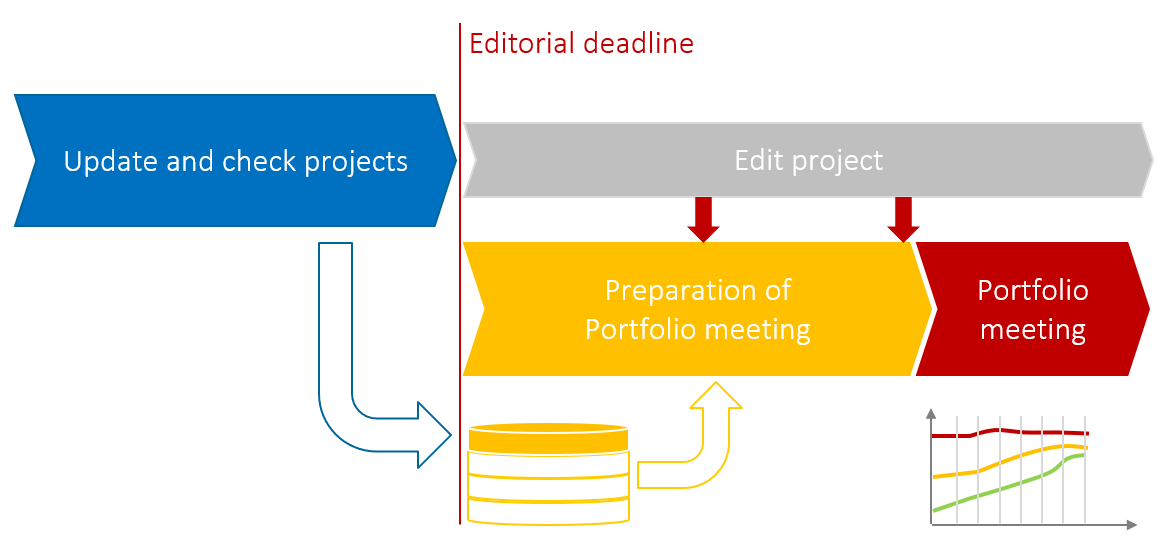
 Our tip:
Our tip:
Use solutions that allow you to automatically create your reports in Excel, PowerPoint or Word in your corporate design. Thus, you make sure the logo is always in the same place and the colors are correct. What is more, the reports are easy to present and print and historize. In most cases, online tools are not as reliable for this purpose. Find a few examples of PMO Reports here.
What Are the Criteria for Projects that Should Be Discussed in the Meeting?
There are no universal criteria for the importance of projects. Possibilities for the selection could include:
- The decision-makers can set certain projects to “important” irrespective of measurable criteria requesting their discussion in every portfolio meeting.
- Generally all “red lights” projects and perhaps also randomly selected ones with a green light making it harder for project managers to easily “hide” behind the color of the traffic light.
- Projects with work or budget above a threshold or top 10.
- Top 10 and other 3-5 of each color (also possible to use as a reward for project managers, if they get to present their project before the board)
- Projects with a high risk assessment
- Projects with need for a decision
- Projects by certain project managers, with certain technologies, from certain sites …
- …
Interesting information from customer projects could include:
- New projects
- • Sales – Stage 50% (offer sent) -> Who will be PM, generic resource allocation
• Sales – Stage 75% (order expected) -> Planning with generic resources
• Sales – Stage 90% (order under way) -> Planning with people, Planning for kick-off
- Ongoing projects
- • Achievement of key content milestones (prototype delivered, UAT Go Live …)
• Adherence to payment milestones, forecast payment plans
• Planned completion due to people changing to other projects
• Information on order extensions
• Far-reaching technological decisions
- Completed Projects
- • Lessons Learned (experience with team, customer, partner, technologies, products …)
Interesting information from product development projects could be:
- New developments
- • New ideas -> Reviewing interesting ideas regarding strategic contribution / costs / benefits
• Under consideration -> Further development of scope, costs and benefits
• Approved -> Next steps decided
• Rejected -> No further activities
• Deferred -> No further activities for the moment
- Ongoing developments
- • Review of research budgets
• Adherence to deadlines and costs regarding the current Stage Gates
• Adherence to deadlines for the start of production
• Review of technological problems and risks
• Review of market-related abort criteria
Conclusion – Project Portfolio Meetings Are Key to Managing Your Multi-Project Landscape
In this article, you have learned what is relevant for a successful and regular project portfolio meeting. As the PMO, you will be successful if all participants perceive this meeting of yours as very valuable. This involves, for example
- Project portfolio meetings have to take place regularly and are obligatory meetings.
- Keep the group of participants rather small, no more than 5 to at most 10 people.
- In case of requests out of sync with the cadence, be sure to refer to the meeting cadence.
- In any case, set an early editorial deadline for the preparation of the meeting.
- Make sure you inform at least the project managers, and possibly also the team leaders, about successes and important decisions from the meeting.
One last recommendation:
Make sure the participants give you feedback at the end of the project portfolio meeting. This is easiest with a star rating Anything below 4 stars has to be explained. Such a rating gives you the opportunity to improve with a clear end in mind. On the other hand, good feedback gathered over time provides an important basis if you have to give proof of the PMO’s benefits. Should anyone question the purpose of your PMO, many good ratings will help you demonstrate how satisfied the stakeholders have been with your work so far. Hence, the PMO cannot be useless.
The project portfolio meeting is your chance to shine as the PMO enabling you to increase acceptance considerably. Good speed!
Our final tips
Get to know the individually adaptable “PPM Paradise” – the optimal environment for your enterprise-wide project, program, portfolio and resource management. Download the eBook now (just click, no form).
And sign up for our bi-weekly blog newsletter to make sure you receive all our updates.
What are your tips for better project portfolio meetings? We look forward to receiving your comment below.
Subscribe to TPG BlogInfo: Never miss new practice-oriented tips & tricks
Every other week: Receive practical tips in TPG blog posts written by recognized experts in project, portfolio, and resource management.
* Required Fields | Data Protection
 Johann Strasser
Johann Strasser
Managing Partner at TPG
The certified engineer, has been a managing partner at TPG The Project Group since 2001. After many years as a development engineer in the automotive and energy sectors, Johann Strasser spent a decade as an independent trainer and consultant in the field of project management. During his tenure, he also served as project manager for software projects in the construction industry and provided scheduling and cost management support for large-scale construction projects. At TPG, he applies his expertise in product development and consulting services for international clients. His special focus is on PMO, project portfolios, hybrid project management, and resource management. For many years now, he has shared his knowledge through presentations, seminars, articles, and webinars.
Read more about Johann Strasser on LinkedIn and XING.
 Achim Schmidt-Sibeth
Achim Schmidt-Sibeth
Senior Marketing Manager
After earning his engineering degree in environmental technology, he gained many years of experience in project management through his work at an engineering office, an equipment manufacturer, and a multimedia agency. Achim Schmidt-Sibeth and his team have been responsible for marketing and communication at TPG The Project Group for many years now.





